Many owners had to find a dried dead tick in a dog. The tick is not dangerous and can not drink all the blood. However, they are capable of carrying infectious bacteria that settle in red blood cells and damage them. Bacteria multiply pretty rapidly, and without proper treatment measures, the disease can lead to the animal’s death.
Every owner should know what serious consequences a tick bite has for an animal, be able to recognize a tick, and provide immediate assistance to their four-legged friend.
How to recognize a dead tick on a dog?
The favorite habitat for a tick is thick bushes (and above 1 meter they do not climb and, contrary to a common mistake, do not jump on us). As a rule, they live in forests and parks, but you can meet them on the lawn in the city center.
When ingested by a dog, the parasite instinctively crawls upwards, which is why it is most often found on the ears, groin area, and thigh folds of the skin. Insects move rather slowly and spend 1-2 hours searching for skin suitable for biting.
Next, the parasite crawls upward looking for a place to stay:
- Abdomen;
- Displacement from depressions;
- Knee and elbow perversions;
- Inner thigh;
- Groin;
- Behind the ears and the ears themselves;
- Mucous membranes – ticks can be found in the oral cavity on the Desna and even on the genitals.
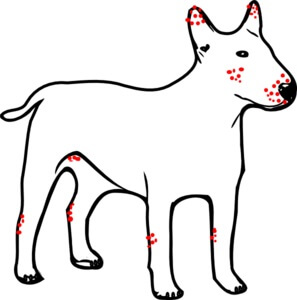
The male bites the dog, drinks blood to an average saturation level, and falls to the ground, while the female sticks to her victim for 8-10 days.
To understand how to find a tick on a dog, you need to know what the parasite looks like. It is not difficult to spot a hungry tick, it looks like a small spider, and it is difficult not to notice a well-fed one. The body of the female tick swells and enlarges several times, and lightens slightly, and when touched it looks like a convex mole, a wart, or a leather pea. And already the dead tick dries up.
The tick can be seen with the naked eye, so inspect your quadruples regularly:
- Run your hand under the wool;
- Feel careful;
- Thin the wool;
- Comb the crest.
The inspection can be done as a game with an animal to minimize its stress from such manipulations.
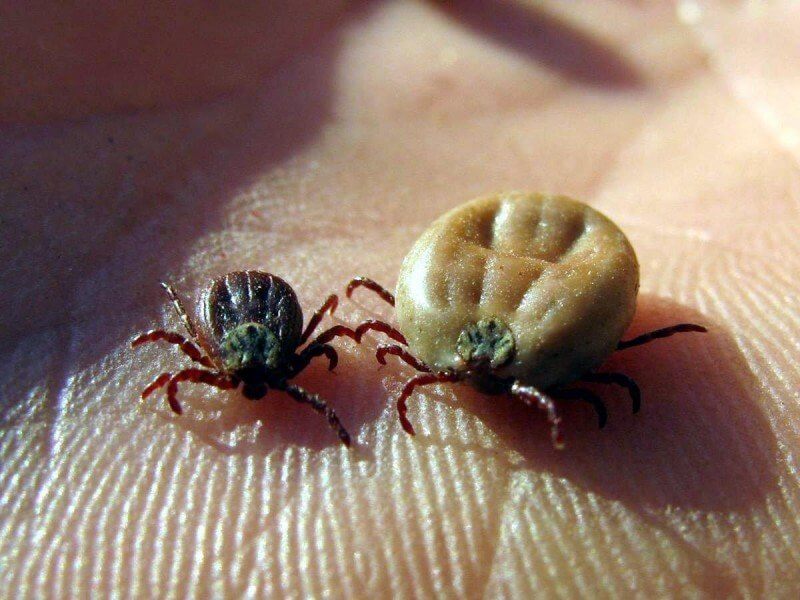
If a dried dead tick is found in a dog, there may be several possible causes:
- The parasite died as a result of the action of alkaloids in the animal’s blood after treatment;
- The dog killed the tick and felt itchy;
- The tick was a carrier of a viral infection, weakened, and died after being paralyzed by alkaloids isolated from the animal’s skin fat.
Attention! A dead tick is usually a sure thing, but to eliminate the slightest suspicion, the parasite must be removed from the pet’s skin and submitted to the laboratory. The tick may be dead and still firmly attached to the dog.
How do I remove a dried dead tick from a dog?
If you find a dried dead tick, do not panic:
- Wear latex gloves or treat your hands with antiseptic / wash well with soap;
- Catch the head of the parasite firmly:
- A crochet to remove ticks (they can be found in the networks of pet pharmacies) is the best and more reliable way. The tick should be hooked and turned clockwise 3-4 times (smoothly). After that, it is not difficult to remove it, and also has no risk of leaving the trunk in the wound;
- Tweezers – pinch the tweezers as close to the skin as possible and pull it out gently but confidently. However, there is a risk of leaving the proboscis in the wound;
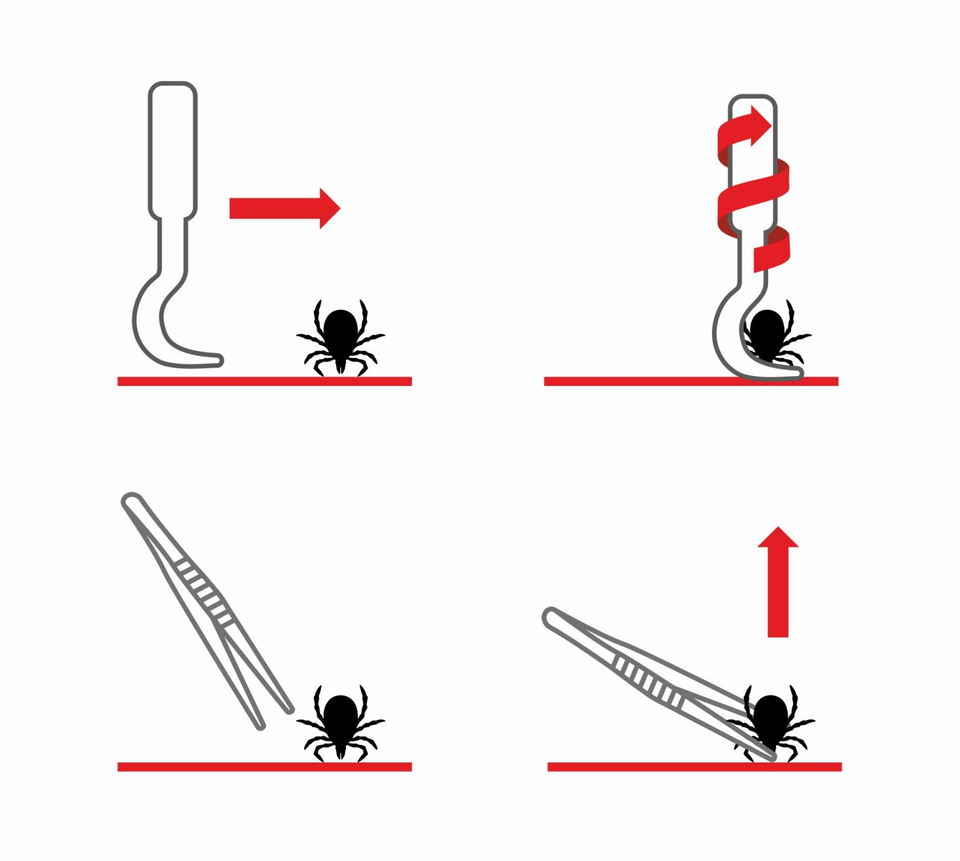
- If part of the head of the tick remains in the skin, do not worry, usually, the body itself will repel the foreign body (although sometimes this is accompanied by a small abscess). You just need to treat the wound with antiseptic and monitor it. If you are very concerned, then seek advice from a veterinary clinic;
- The wound should be treated with antiseptic (you can use hydrogen peroxide, a solution of chlorhexidine, or betadine), green or iodine will not work;
- Place the tick in the container and close the lid. Save the tick to perform a laboratory experiment to identify the disease it may infect your dog with. If you do not plan to do this, burn the insect – without removing it from the jar under a closed lid.
What not to do when disarming a tick
The Internet is full of harmful advice. Someone advises cauterizing the tick with celandine juice, someone – to attach a copper coin for a full moon. It is clear that esoteric and folk methods are unlikely to work, so consider myths that are close to reality.
1. Pour the tick with oil and then it will come out by itself – the most common myth. No, it will not come out, in fact, it can climb deeper and actively release salivary fluid – in fact, it contains the simplest, which are so dangerous for the dog.
2. Smear the tick with nail polish. Yes, the tick may die, but you still need to pull it out. In addition, for this reason, irritation and inflammation of the skin may occur on the chemical composition of the varnish.
3. Gasoline. Possible consequences are allergies and skin irritation.
4. When you remove the tick, you do not need to pull sharply and try to tear the tick from the dog.
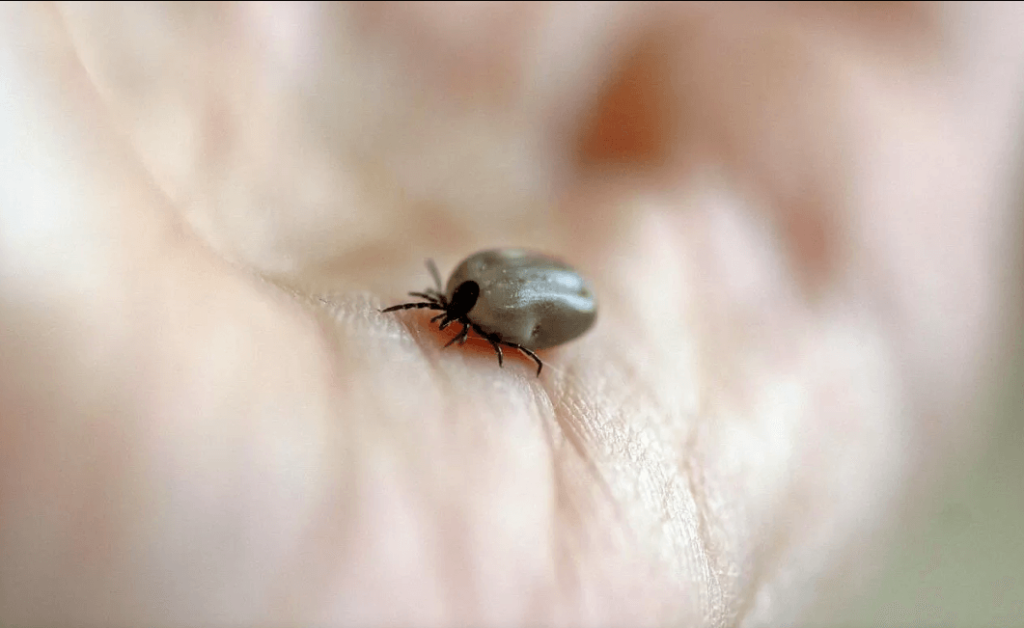
Tick-borne infections in dogs
If your dog is treated for ticks on time and by weight, then simply observe the animal for 10-14 days, but the likelihood of the dog becoming infected is minimal. If the animal was not protected in any way, in addition to observation, it is better to take the tick to the veterinary laboratory for examination. There the parasite will be tested for disease and brought to a result.
According to the results, your veterinarian will prepare a further treatment and prevention plan.
Most diseases are not transmitted immediately in the morning, but 12-48 hours after the bite (with the exception of ehrlichiosis, which is transmitted much earlier). And if you pulled a tick out before that time, infection is unlikely. But if you pulled it out only 2-3 days after the bite or later, in this case, the positive conclusion of the laboratory about the presence of blood parasitic diseases in the tick may be a reason to contact the veterinary clinic before the dog has the first clinical signs of the disease.
The list of the main diseases transmitted from the tick to the dog: Pyroplasmosis (babesiosis), Ehrlichiosis, Anaplasmosis, and Lyme disease.
In order not to lose valuable time, remember the general symptoms of diseases:
- Loss of appetite;
- Lethargy and fever;
- Vomiting and diarrhea;
- Drowsiness;
- Pallor or yellowing of the mucous membranes;
- The urine of a rich orange or red color;
- Enlarged lymph nodes;
- Blood clotting disorders – the blood cannot stop even from a small wound for a long time;
- Weakness of the hind limbs.
If you observe any of the above symptoms in your pet, contact a veterinarian as soon as possible!
ATTENTION: Some infections are difficult to detect on your own, so veterinarians recommend taking a tick to the lab for testing and detecting infections in them.
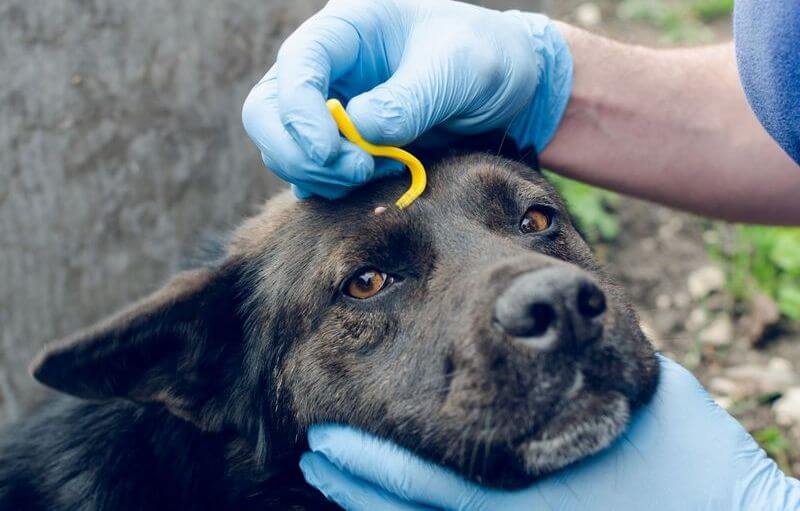
Prevention
First of all, it is necessary to limit all contact with street dogs and carefully examine the dog’s skin and hair immediately after walking on the street.
There are prophylactics that can prevent bites: shampoos, drops, sprays, tablets, and collars.
The main effect of all these drugs begins in 5-7 days, so it is necessary to treat the animal in advance. And for better protection you can combine drugs: Drops + collar or drops + spray. It is this combination that will be reliable because in the event of a fall in the rain or after bathing, the effect of drops weakens.
- Collar. The collar of ticks is more suitable for short-haired animals and should be worn so that there is a distance of about 2 cm between the collar and the neck of the dog. Due to the fact that the collar is intended for long-term wear, it is important that it is as safe as possible for the animal.
- Drops and aerosols. For long-haired dogs, it is better to use drops selected by the weight of the dog. It is important to apply drops from the tube properly to the skin. Usually, it is recommended to drip drops in the area of withers.
- Spray. This tool kills ticks quickly and efficiently. Aerosols can be used together with shampoos. Be very careful when using this product, it is especially dangerous for the eyes.
- Shampoos. Shampoos from ticks for dogs contain ingredients with a medicinal substance that kills insects on contact. The process of bathing an animal must be repeated every two to three weeks.
Do not neglect the treatment of the animal, because prevention can save the life of your pet.
Conclusion
There are effective means to protect dogs from ticks, but even if you use them, do not forget and do not be lazy to inspect your pets after a walk. Excessive forelegs will not hurt.
Finally, there are some interesting facts about the life of ticks:
- Ticks live up to four years and feed on blood only 3 times.
- Can be moved up to 10 thousand eggs.
- After eating, they can increase their weight by 100 times.
- Active at a ground temperature above 3-5⁰.
- During the year, the tick is dangerous from March to November, but do not forget the above paragraph: it all depends on the climate and temperature.
